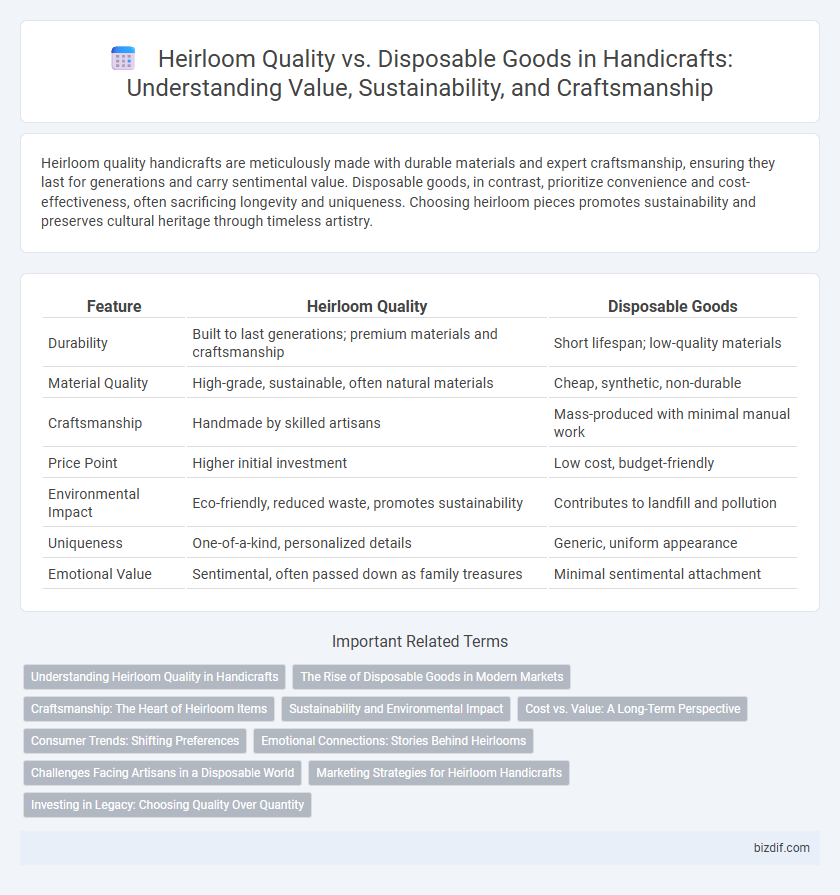Heirloom quality handicrafts are meticulously made with durable materials and expert craftsmanship, ensuring they last for generations and carry sentimental value. Disposable goods, in contrast, prioritize convenience and cost-effectiveness, often sacrificing longevity and uniqueness. Choosing heirloom pieces promotes sustainability and preserves cultural heritage through timeless artistry.
Table of Comparison
| Feature | Heirloom Quality | Disposable Goods |
|---|---|---|
| Durability | Built to last generations; premium materials and craftsmanship | Short lifespan; low-quality materials |
| Material Quality | High-grade, sustainable, often natural materials | Cheap, synthetic, non-durable |
| Craftsmanship | Handmade by skilled artisans | Mass-produced with minimal manual work |
| Price Point | Higher initial investment | Low cost, budget-friendly |
| Environmental Impact | Eco-friendly, reduced waste, promotes sustainability | Contributes to landfill and pollution |
| Uniqueness | One-of-a-kind, personalized details | Generic, uniform appearance |
| Emotional Value | Sentimental, often passed down as family treasures | Minimal sentimental attachment |
Understanding Heirloom Quality in Handicrafts
Heirloom quality in handicrafts signifies exceptional craftsmanship, durability, and timeless design that allow items to be cherished and passed down through generations. These crafts often use premium materials, meticulous techniques, and detailed finishing, distinguishing them from disposable goods designed for short-term use. Understanding the value of heirloom quality highlights the cultural significance and sustainability of preserving artisanal heritage.
The Rise of Disposable Goods in Modern Markets
The rise of disposable goods in modern markets has significantly impacted the handicraft industry, favoring mass-produced, low-cost items over heirloom-quality pieces. Market demand increasingly prioritizes affordability and convenience, leading to a decline in consumer interest in durable, handcrafted products with lasting value. This shift challenges traditional artisans who emphasize craftsmanship, sustainability, and cultural heritage in their work.
Craftsmanship: The Heart of Heirloom Items
Craftsmanship stands as the defining feature of heirloom quality, where skilled artisans invest meticulous attention to detail, ensuring durability and timeless appeal unmatched by disposable goods. Hand-forged joints, hand-stitched fabrics, and carefully selected materials contribute to heirlooms' strength and character, allowing these items to be treasured across generations. Unlike mass-produced disposable products, heirloom crafts embody a commitment to sustainability through longevity and emotional value.
Sustainability and Environmental Impact
Heirloom quality handicrafts, crafted with durable materials and meticulous techniques, significantly reduce waste by offering long-lasting alternatives to disposable goods that often end up in landfills. Sustainable production methods prioritize resource conservation and minimal environmental footprint, contrasting sharply with the mass-produced disposables designed for short-term use. Investing in heirloom quality supports ecological balance by minimizing pollution, reducing energy consumption, and promoting circular economies in the handicraft sector.
Cost vs. Value: A Long-Term Perspective
Heirloom quality handicrafts often require a higher initial investment but provide exceptional durability, unique artistry, and lasting emotional value, unlike disposable goods that may save money upfront but necessitate frequent replacement. Over time, heirlooms retain or even appreciate in value due to their craftsmanship and cultural significance, making them cost-effective assets in the long term. Investing in heirloom-quality pieces supports sustainable consumption by reducing waste and promoting timeless utility.
Consumer Trends: Shifting Preferences
Consumers increasingly prefer heirloom-quality handicrafts due to a growing awareness of sustainability and durability over disposable goods. Market data indicates a rise in demand for artisan-made products that offer unique craftsmanship and longevity. This shift is driven by eco-conscious buyers valuing ethical production and timeless design that transcends mass-produced alternatives.
Emotional Connections: Stories Behind Heirlooms
Heirloom-quality handicrafts carry deep emotional connections through the stories embedded in each piece, passed down across generations as tangible memories. These handcrafted items often represent family heritage, cultural identity, and personal milestones, contrasting sharply with the impersonal nature of disposable goods. The sentimental value and craftsmanship of heirlooms create lasting bonds that transcend material worth, enriching family narratives and preserving history.
Challenges Facing Artisans in a Disposable World
Artisans creating heirloom-quality handicrafts confront significant challenges in a disposable world dominated by mass-produced goods with short life spans. The demand for sustainable, durable products often clashes with consumers' preference for low-cost, easily replaceable items, limiting artisans' market reach and profitability. Preserving traditional craftsmanship requires overcoming economic pressures and educating consumers on the value of longevity and cultural heritage embedded in heirloom-quality pieces.
Marketing Strategies for Heirloom Handicrafts
Heirloom handicrafts emphasize exceptional durability, unique craftsmanship, and timeless design, distinguishing them from disposable goods through their long-term value and emotional significance. Marketing strategies for heirloom handicrafts leverage storytelling, showcasing artisans' expertise and cultural heritage to connect with discerning customers seeking authenticity and sustainability. Highlighting the product's longevity, investment appeal, and eco-friendly attributes effectively positions heirloom handicrafts as premium alternatives to mass-produced, short-lived items.
Investing in Legacy: Choosing Quality Over Quantity
Heirloom quality handicrafts are meticulously crafted using durable materials and traditional techniques, ensuring longevity and timeless beauty that transcends generations. Investing in these masterpieces fosters sustainable consumption by reducing waste and valuing artistry over mass-produced disposables. Prioritizing quality over quantity preserves cultural heritage and creates meaningful legacy pieces that hold sentimental and monetary value over time.
Heirloom Quality vs Disposable Goods Infographic

 bizdif.com
bizdif.com